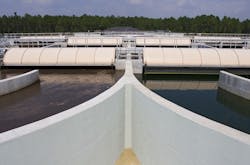CLR Process Uses Rotor Aerator to Provide Oxygen & Mixing
The Lakeside closed loop reactor (CLR) process, a modified form of the extended aeration complete mix process, provides biological nutrient removal using nonproprietary, energy-efficient designs. CLR processes produce removal efficiencies that meet and exceed those of advanced tertiary treatment processes. Biological nutrient removal configurations are available with in-basin designs for nitrification and denitrification, as well as external selector configuration for biological phosphorus and total nitrogen removal. Process monitoring and control systems can be provided to continuously monitor and adjust the operation of the biological reactors to optimize process performance and reduce power costs.
A vital component of the CLR Process is the horizontal bladed rotor aerator. Lakeside’s Magna rotor aerator provides oxygen and mixing to the basin with reliable operation and high efficiency.
The Lakeside Magna rotor offers a typical oxygen transfer range of 3.3 to 3.6 lb oxygen per brake hp, depending upon the rotational speed and blade immersion. The combination of rotational speed and immersion range provides an oxygen transfer range of 9.7 to 1. This flexibility allows the plant operations staff to easily match the specific oxygen uptake rate of the process. The flexible oxygen transfer that is provided by the Magna rotors allows for the mixed liquor dissolved oxygen to be properly maintained during the initial startup of the plant, where the influent biological oxygen demand (BOD5) and total Kjeldahl nitrogen loadings may be as low as 20% of the ultimate design of the plant. The blades are formed of corrosion-resistant 10-gauge stainless steel that is die-formed. Unlike designs that utilize plastic blades or discs that become brittle in cold weather and can break, the Magna rotor blades can take a 250-lb load without deformation or damage.
